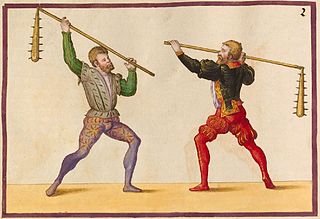
A military engineering vehicle is a vehicle built for construction work or for the transportation of combat engineers on the battlefield. These vehicles may be modified civilian equipment or purpose-built military vehicles. The first appearance of such vehicles coincided with the appearance of the first tanks, these vehicles were modified Mark V tanks for bridging and mine clearance. Modern military engineering vehicles are expected to fulfill numerous roles such as; bulldozer, crane, grader, excavator, dump truck, breaching vehicle, bridging vehicle, military ferry, amphibious crossing vehicle, and combat engineer section carrier.

A scourge is a whip or lash, especially a multi-thong type, used to inflict severe corporal punishment or self-mortification. It is usually made of leather.

A flail is a weapon consisting of a striking head attached to a handle by a flexible rope, strap, or chain. The chief tactical virtue of the flail is its capacity to strike around a defender's shield or parry. Its chief liability is a lack of precision and the difficulty of using it in close combat, or closely-ranked formations.

Hobart's Funnies is the nickname given to a number of specialist armoured fighting vehicles derived from tanks operated during the Second World War by units of the 79th Armoured Division of the British Army or by specialists from the Royal Engineers.

The 79th Armoured Division was a specialist armoured division of the British Army created during the Second World War. The division was created as part of the preparations for the Normandy invasion on 6 June 1944, D-Day.
The aardvark is an African mammal, Orycteropus afer.

The Westminster Dragoons (WDs) was a yeomanry regiment of the British Army Army Reserve, located in central London. Its lineage is continued by one of the Royal Yeomanry's six squadrons. Formed in the aftermath of Second Boer War as part of the County of London Yeomanry, the WDs fought in the Battle of Gallipoli and led British forces onto the beaches during the Normandy Invasion in 1944. The squadron most recently saw action in Operation Telic for which it was mobilised for the 2003 war in Iraq.

A mine flail is a vehicle-mounted device that makes a safe path through a minefield by deliberately detonating land mines in front of the vehicle that carries it. They were first used by the British during World War II.

Flail chest is a life-threatening medical condition that occurs when a segment of the rib cage breaks due to trauma and becomes detached from the rest of the chest wall. Two of the symptoms of flail chest are chest pain and shortness of breath.

The M4 Sherman tank was produced in several variants, a result of mass production spread across several manufacturers and several years. It was also the basis for a number of related vehicles and Shermans have been modified by several nations, ranging from upgrades to complete hull conversions for another task. Originally designed in 1941, M4 variants were still used by Israel during the 1967 and 1973 wars with its Arab neighbors.

The crook and flail were symbols used in ancient Egyptian society. They were originally the attributes of the deity Osiris that became insignia of pharaonic authority. The shepherd's crook stood for kingship and the flail for the fertility of the land.

The Sisu RA-140 DS "Raisu" is a flail-type demining vehicle developed and produced by the Finnish company Sisu-Auto and later produced by Patria Vehicles in the years 1994–2001. The production totalled 41 units.

The Corps of Engineers (ENGR) is the military engineering branch of the Defence Forces of Ireland. The Corps is responsible for combat engineering, construction engineering, and fire fighting services within the Defence Forces. The main role of the combat engineers is to provide engineering on the battlefield; the Corps has successfully leveraged its skill and expertise in several of the Irish Army's deployments on United Nations operations.

The Aardvark AMCS Mk4 is a British-made mine flail vehicle built by Aardvark Clear Mine Ltd of Dumfries, Scotland.

A flail mower is a type of powered garden/agricultural equipment which is used to deal with heavier grass/scrub which a normal lawn mower could not cope with. Some smaller models are self-powered, but many are PTO driven implements, which can attach to the three-point hitches found on the rear of most tractors. This type of mower is best used to provide a rough cut to long grass and even brambles in locations such as roadsides, where contact with loose debris may be possible.

The Mines Advisory Group (MAG) is a non-governmental organization that assists people affected by landmines, unexploded ordnance, and small arms and light weapons.
The Battle of Broekhuizen, a Dutch village near the Meuse, was a small but bloody battle which took place late in 1944 as part of the Allied campaign to liberate the left bank of the Meuse in the Netherlands.
Keiler is a German river icebreaker.

Keiler mine flail is a mine-clearing vehicle developed by Rheinmetall in Germany to meet the requirements of the German Army. It is a conversion of the M48 Patton medium tank chassis in combination with a German MTU MB 871 Ka 501 liquid-cooled turbocharged Diesel engine. The main role of the Keiler vehicle is to clear a lane through minefields to ensure the safe passage of soldiers and vehicles. A deployable mine flail system has been fixed to the front of the vehicle, which is used to clear both anti-tank and anti-personnel mines. Between 1997 and 1998, 24 vehicles of this kind were produced for the German Army.
This page is based on this
Wikipedia article Text is available under the
CC BY-SA 4.0 license; additional terms may apply.
Images, videos and audio are available under their respective licenses.















